N1443D
![]()
N1443D |
|
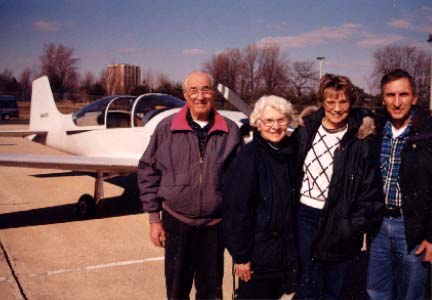
Steve, Ann, Debbie and Al Dubiak
The Garmin GNS-430 GPS worked perfectly and allowed me to compare the GPS ground speed readout with the airspeed indicator, satisfying me the airspeed gauge had adequate accuracy for flight. Directional control taxi tests proved adequate directional control existed at airspeeds on the runway up to about 50 KIAS. Lateral control taxi tests indicated slightly different results between left and right applications of full aileron. As I slowly accelerated with full left stick, there seemed to be little response in terms of right wing rise until about 43 KIAS, at which point the right wing showed a slightly abrupt rise. The same test repeated with full right stick produced a more typically gradual rise of the left wing beginning at about 20 KIAS.
The elevator control test was a little dicier. Holding full aft stick from the beginning of the run, I slowly accelerated and, at about 10 to 20 KIAS, I pumped the stick full forward and was able to compress the nose strut as expected. Returning the stick to full aft, I noticed no rise in the nose until about 45 KIAS at which point the nose began a slightly abrupt rise. I immediately neutralized the stick and retarded the throttle to idle but somehow bumped the throttle back up and the Falco lurched forward in what seemed like a hop and a skip before I was able to get the throttle back and the airplane under control again. It definitely wanted to fly.
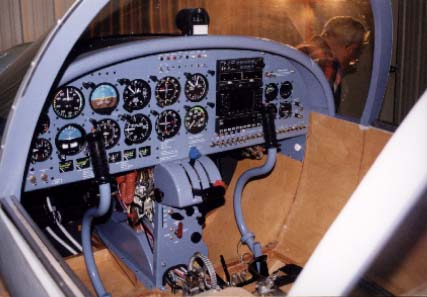
The taxi tests now complete, I taxied into the ramp area at the base of the DuPage airport tower. There was a sizable crowd of Al and Debbie's friends and family members, all with cameras and many with video cameras and tripods. We gassed back up to half a tank in each of the front and aft tanks and looked the airplane over carefully for signs of problems of which we found none. The weather had almost completely cleared up, there was still a little over an hour of daylight left and there just wasn't any longer any reason to stay on the ground. I had a mission to accomplish and thought it best I get it done.
Fired up again, I taxied to runway 19R and accomplished one last engine run up and check, completed the checklists and called tower for takeoff clearance requesting a gradual climbing right turn to remain over the airport at 3,500 feet MSL. Clearance received, I taxied onto the runway, stopped and reset the directional gyro and, at 5:00 pm CST that Tuesday, smoothly added full power and began the takeoff roll that completed this chain of events started by two young Ukrainians nearly a century ago.
Acceleration was quick, requiring a moderate amount of right rudder to counter the torque, and with slight aft stick the Falco broke ground at 60 KIAS and climbed away at about 12 degrees attitude and an estimated 30 degrees climb angle. I left the gear down, the power full, raised the flaps at 2,000 feet MSL and turned off the auxiliary fuel pump. Leveling at 3,500 feet MSL required a reduction in power to about 17 inches of manifold pressure and about 2,400 RPM in order to remain below the gear speed of 108.5 KIAS. All of the engine instruments had remained in the green and the engine ran smoothly throughout the climb and level off. Now there was time to simply enjoy the smoothness and harmony of the Falco's famous controls and get to know Al's airplane a little better.
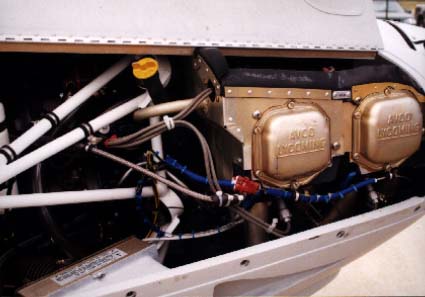
After a few racetrack patterns over the field in both directions, I performed a series of controlled descents and climbs in the flaps up configuration first and then in the flaps 20 degree configuration. Noting the power requirements for each, I recorded engine parameters once again in level flight, reviewed the spin recovery procedures I had included in my test cards, and prepared for a series of approaches to stall and then actual stalls.
The purpose for the approaches to stall testing was to determine the type, degree and duration of stall warning, if any, prior to a stall in any of several configurations and power conditions. It is important to know what to expect in terms of stall warning before attempting a landing approach at normal approach speeds. The Falco usually provides a narrow, 5-to-7 KIAS duration of slight buffet or burble prior to actual stall, depending on where the builder installed the stall strips on the leading edge of the wing. Al's Falco provide light but noticeable buffet at 65 KIAS in the flaps up configuration with power at idle. In the flaps 20 degree configuration and idle, stall warning was more in the form of low frequency nose bob beginning at 56 KIAS.
Due to traffic inbound to Chicago's O'Hare airport, I was constrained
to 3,500 feet MSL or below and therefore had to dispense with
the power-on approaches to stall and stall tests. It was just
as well considering I was quickly running out of usable daylight
and would have to land soon. So I focused on the priority of finding
the actual stall speed in the landing configuration of gear down,
flaps 20 degrees and power at idle. I found the stall speed at
54 KIAS and the stall was defined as a mild nose drop with no
tendency to drop a wing on either side. That was a surprise for
me as my experience with Falcos has taught me to expect a rather
abrupt wing drop at stall. I suppose the reluctance of Al's Falco
to do so is testimony the accuracy of alignment with which he
and his father built the wing and tail structures.
Armed now with the dirty stall speed data, it was a simple calculation
of 1.3 times that stall speed to determine the minimum "over
the fence" approach speed of 70 KIAS. I descended into the
right downwind for runway 19R at 85 KIAS in the landing configuration
and slowed to 70 KIAS on short final. The wind was light out of
the south, and the Falco was flying smooth and felt very solid.
The flare was easily controllable and Al's Falco touched down
softly on it main wheels at 5:55 pm after what I would characterize
as a very successful first flight.
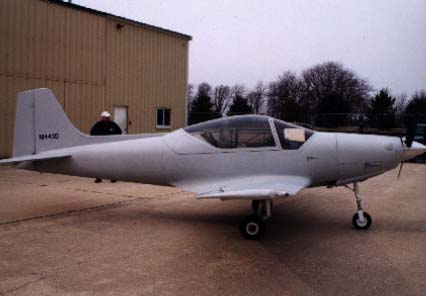
I taxied all the way back to Al's hangar where the crowd met me shutting down. Al Dubiak was walking briskly toward me, his wide smile recognizable I'm sure from the other side of the field. I slid the canopy back with one finger and struck a now familiar and very gratifying pose of me extending my hand in congratulations to the builder of what I view in this case to be an exceedingly exemplary specimen of designer Stelio Frati's wooden masterpiece-the Falco.
After putting his airplane to bed for the night, Al drove me home to his house for dinner. We were quiet. Al is naturally a man of few words, and I was drained from the day's efforts, the 3:00 am get up in Washington and having just begun to contemplate the gravity and responsibility I had assumed in placing at some risk this invaluable asset that had become a focal point of his family's life over the course of 11 years. Not to mention the fact that I was in pain having been crunched and hunched over under that Nustrini canopy for over two hours total. After some time, Al asked me what it was like to do that-to test fly a new airplane like that. He said it must take a lot of "guts". I quite honestly didn't know how to answer that. I've never really given it much thought. I've never really allowed emotion to enter the process. So I simply said I thought it was merely an exercise in managing risk and that's the reason for the logical progression of events as laid out in the Falco Flight Test Guide.
Then I asked Al what it was like to watch his own creation take to the air for the first time. I explained I did not know because I haven't yet finished mine and probably never will know because when I finally do finish my Falco, I'll be the test pilot. Al thought for a moment and quietly said, "I got choked up".
In the morning, we picked up his father and returned to DuPage airport for another day of flying. The weather was beautiful early in the morning, but the snow clouds were moving in. We needed to remove the cowling to investigate a small leak of some kind that we noticed caramelizing on the number two cylinder exhaust stack. It turned out to be fuel leakage from the exhaust stack gasket, those thin little copper gaskets that hardly seem capable of stopping water let alone hot cylinder exhaust gas escaping under pressure. Al had installed one at each exhaust stack, and as it turns out, two are required by an obscure Lycoming Service Bulletin, a copy of which Al had neatly filed in his fastidiously kept records of his project. That fixed, we buttoned her back up and were on our way.
The second flight found Al Dubiak in the left seat at the controls of his own creation. His sitting height appeared to be somewhat shorter than mine, and he seemed to feel relatively comfortable in his cozy cockpit. I returned to my hunched over and inward leaning position this time in the right seat. Starting and taxiing were now already familiar events for Al, and we arrived at the hold short line for runway 19R in short order. Run up and checklists complete, I explained to Al the sensitivity of the Falco to control inputs and suggested he rest his forearm on his leg and delicately hold the stick with only his thumb and two finger tips.
Lined up with clearance, Al smoothly advanced the throttle to full and off we went. Al seemed amazed at the acceleration of his Falco to the point he was a little late in rotating which resulted in the Falco sort of skipping down the runway on all three tires for a short distance at flying speed not unlike a smooth flat stone skipping across a glassy lake. Airborne on climb-out, Al was learning rapidly the realities of the Falco control sensitivity I had been talking about at the hold short line. I looked at his left hand on the control stick and found it clenched like a fist around the grip with his forearm freely hanging well away from his leg. In that fashion, we wiggle-waggled our way out west to the approved operating area. Over time, Al settled down from what I am sure must have been near unbridled excitement, and we climbed to 4,500 feet AGL over a frozen lake to allow time for Al and his Falco to get acquainted.
Landing gear retraction tests were on the schedule for this flight. After 30 minutes or so of climbing, descending and turning, it was time to fly level in a straight line and accomplish our purpose. I held the Falco Flight Test Guide while Al flew. Slowed to 100 KIAS, we ensured the gear retraction motor knob was disengaged and then Al placed the gear switch to up. The gear motor ran in the gear up direction for a few seconds until Al placed the gear switch back down. I re-engaged the gear motor knob and ensured the gear crank handle was disengaged and out of the way. Al placed the gear switch up once again, and the gear motor and all three screw jacks came to life. I never asked Al which motor he had installed, the slow or the fast, but judging from the 12 to 14 seconds or so of up travel before the in-transit light went out, I would say he has the slower, higher torque motor. We double-checked the gear circuit breaker and found it had remained in. Then we did one last test on the gear warning light and horn by reducing the throttle to less than 17 inches of manifold pressure at which time the amber gear warning light and horn came on as advertised.
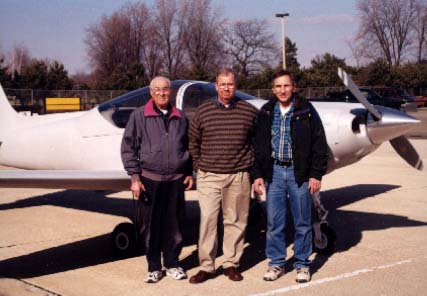
Steve Dubiak, Al Aitken and Al Dubiak.
With the gear up and the throttle advanced to about 20 inches or so, Al's Falco accelerated without hesitation to about 140 KIAS. It was now time for the moment of truth. So we slowed back down below 108.5 KIAS and placed the gear switch back down. Again, the gear mechanism sprang to life, shortly followed by a very welcome little green light indicating the gear was probably down and adequately locked. I say probably because it was still necessary to determine if the gear overcenter linkages were in fact over center. The only way to be sure of that was to see if the screw jacks had pushed themselves sufficiently into the springs, and that could only be determined by hand cranking the gear further in the down direction and counting the turns. Since it takes approximately three and a half turns to fully compress the overcenter springs, we were looking for less than three and a half turns in our hand cranking effort. We were able to turn the crank only one half of a turn before bottoming out, indicating the springs were near fully compressed and the overcenter linkages were in fact over center. We tried the test twice and achieved the same result each time, so we were satisfied the gear were safely down and locked.
We had been in the area nearly an hour now, and I wanted plenty of time and fuel left for Al to get multiple landings and takeoffs before we quit. So I demonstrated for Al both a clean and a dirty stall, and we headed back to the DuPage airport. I showed Al the first landing, and he did the next ten or twelve himself we lost count. With each landing, Al became more familiar with his Falco in its landing configuration and in the flare. His twelfth was near perfect, and after nearly two hours and 20 minutes of fun, we decided to call it a day and return to his hangar. As we taxied to his ramp, I could see his father coming through the gate toward us, wearing an unmistakable smile on his 86-year-old face and obviously very proud of his son. He had longing in his eyes, a definite yearning to go flying with Al in this magnificent machine of beauty he had helped create. Be patient, my friend. The 25 hours of required fly-off time will pass quickly enough. Maybe you'll have your first flight in your Falco on your 87th birthday next month.
The whole two-day affair was surprisingly efficient, and I
thank Al Dubiak and his family for their hospitality and their
trust. It was an honor, and a rare and satisfying opportunity
to be a part of it.
|
|